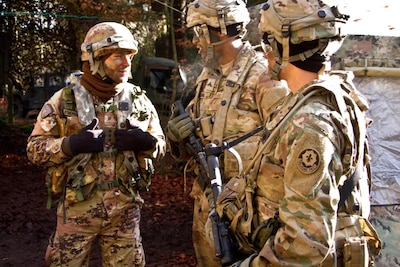By Army Staff Sgt. Kathleen Polanco, 7th Army Training
Command
HOHENFELS, Germany, Nov. 17, 2017 — "It's very
important for us to train together with our partners," said Col. Arturas
Radvilas, the commanding officer of the Lithuanian army’s Motorized Infantry
"Griffin" Brigade.
"For us, this is the most important thing because it's
a multinational exercise," Radvilas added.
Radvilas is talking about Allied Spirit VII, a 7th Army
Training Command-conducted multinational exercise that focuses on tactical
interoperability and testing secure communications among NATO members.
The exercise, which began Oct. 30, is being held here until
Nov. 22. There are approximately 4,000 participants from 13 nations: Czech
Republic, Denmark, France, Germany, Hungary, Italy, Lithuania, Poland,
Portugal, Slovenia, Spain, the United Kingdom and the United States.
Working Together
"The importance of Allied Spirit is to bring our NATO
partners together in a cohesive exercise where we can test and exercise our
alliance together to prove interoperability, have situational understanding,
learn tactics and maneuver, and increase our ability to integrate these forces
to work together as a full team," said Brig. Gen. Jeff Smiley, the deputy
commanding general of the 40th Infantry Division, California Army National
Guard.
The three-week exercise integrates different forces into one
multinational brigade, with Lithuania taking the lead as the higher command.
Lithuania provides mission command of fire support, offensive, defensive and
stability tasks, while concurrently operating a command post exercise at the
Warfare Training Center in Nemencine, Lithuania.
In the first week, the participating nations spent time
getting to know each other's procedures, capabilities and systems through
improvised explosive device awareness training, route clearance and vehicle
recovery. Some of the other training objectives included media engagements:
civilian-military integration; medical training; and chemical, biological,
radiological and nuclear defense.
Integrated Training
This integrated training was an invaluable asset for the
California Army National Guard unit to take home as the soldiers don't often
receive many opportunities to train with allied partners, Smiley said.
"We have a lot of experience in working with law
enforcement, fire services, local government, and county and state governments,"
Smiley said. "Well, those experiences really play out very well over here
in this complex environment where we get to interface."
After a week of refresher training, the units familiarized
themselves with the training area by moving into their fighting positions as
they prepared for the main exercise days to begin.
‘Totally Different’ Training
"It was totally different from what we normally do
because most of our training is conducted in Canada on wide-open
prairies," said Lt. Col. Jez Lamb, the United Kingdom's 1st Battalion,
Royal Regiment Fusiliers, first-time participants in the exercise. "But
here, maximum ranges are about 50 meters, so it's very close. We can't form
nice open formations, so the whole thing is totally different."
After familiarization with the training area’s terrain, and
understanding everyone's involvement and capabilities, the Fusiliers and the
rest of the multinational brigade were ready to take on the opposing forces.
Exercise participants are challenged to apply their training
and integrate their skills to conduct recons, dismounts, attacks and defensive
operations as one interoperable fighting force.
"This is a unique opportunity for us to be trained
here," Radvilas said. "Being able to learn from our partners and
understand them is very important for us."

No comments:
Post a Comment